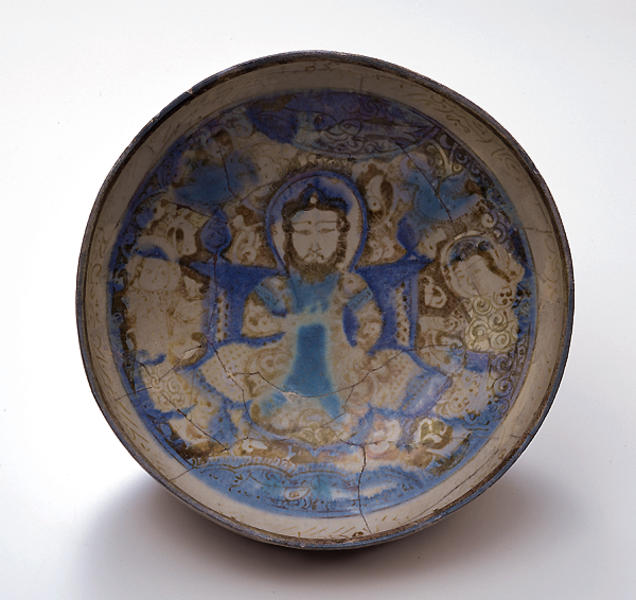ラスター彩玉座図鉢
- イラン 伝スルターナーバード
- 1226/27(ヒジュラ暦624)年
- 複合陶土
- H-10.7 D-20
この作品は中央の玉座に座った髭のある貴人と従者が描かれ、足元の池に魚が泳いでいる。宮廷人の生活を思わせる情景で、権力や輝かしい偉業と繁栄の様を後世に残そうとしたようだ。部分的に下絵付けの藍彩で彩られ、外側にナスヒ体の銘文があるところが極めて重要な作品である。
Catalogue Entry
This work features an bearded nobleman enthroned in the center. Designs of an enthroned figure granting an audience, along with those of rulers playing musical instruments and at falconry, describe both official and private life of the court. By depicting their life in this way, rulers seem to have wanted to demonstrate their power, achievements, and wealth, as well as record them for future generations. The theme of royalty had often been used in tableware of precious metals in ancient Iran, and in Islamic times it was an ideal theme for mina'I and lusterware made for rulers and high-ranking officials.
The fish swimming in a pond at the foot of the nobleman are interpreted as having esoteric implications. Two fish laid out symmetrically in the upper part of a semicircle might be a design of a canopy, or represent Pisces, a sign of the zodiac.
The garments of the nobleman and the throne were incompletely colored dark blue in underglaze painting. Technically, the colors did not come out very well, but because the date of manufacture, A.D. 1226, is included in the Naskhi inscription on the outside, this bowl constitutes an extremely important document. Persian lusterware developed at about the time of the fall of the Fatimid dynasty (A.D. 1171) in Egypt, when potters with this special skill left Egypt and migrated to Iran looking for new patrons. The oldest examples of Persian lusterware are fragments inscribed with the year 1179 (575 A.H.); a slightly older fragment of a bottle dated 1139-40 was discovered recently. Lusterware flourished in Iran (Persia) from at least this date.
Lusterware not only requires complicated and advanced skills in low-temperature reduction firing, but also is expensive to produce because it has to be fired once more, after the overglaze design is drawn with metal oxide, incurring high fuel costs. Lusterware cannot be made by anyone in Iran today, and it is probable that it was produced by a limited number of families of prosperous potters who were patronized by influential clients.1 The main centers of lusterware production were Rayy, Kashan, and Saveh. A recent excavation has proved that this ware was also fired in Jurjan, in the north of Iran. In 1301 Abu'l-Qasim, a potter from Kashan, wrote that Kashan was a production center of lusterware, and several pieces with inscriptions of a potter's name (nisbah) or an inscription using the name of Kashan confirm the position of this city as a production center.
TS
1. Allan l973; Watson l975.
